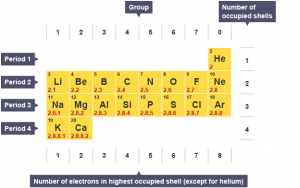General Periodic Table research
When I was first introduced to this project by Kyle I immediately thought oh no I don’t remember ANYTHING from school about the periodic table ( I wasn’t aware I would be needing this information for my uni course). So that is what this blog post is about- the main facts about the periodic table. I want to get the main information and refresh what I used to know, as a good base for my research before I begin brainstorming and idea for this digital product, below is some notes I took about the periodic table-
The definition of the periodic table-
The periodic table, also known as the periodic table of chemical elements, is a tabular display of the chemical elements. It is widely used in chemistry, physics, and other sciences.
Back to Bitesize
So I went back to Bitesize (which is throwing it way back to my primary school days) I thought this would give me a nice simple over view of the main points and actually on the website they had some great diagrams with a good level of information and they very easy to read understand.
Reading the table
The periodic table contains an enormous amount of important information but here are some of the basics:
Atomic number: this is the number of protons in an atom is referred to as the atomic number of that element. This number of protons defines what element it is and also determines the chemical behavior of that element. For example, carbon atoms have six protons and hydrogen atoms have one.
Atomic symbol: The atomic symbol (or element symbol) is an abbreviation chosen to represent an element (“C” for carbon, “H” for hydrogen and “O” for oxygen, etc.). These symbols are used internationally.
Atomic weight: The standard atomic weight of an element is the average mass of the element in atomic mass units (amu). The atomic mass on the periodic table is stated as a decimal number because it is an average of the various isotopes of an element.
Metals, non-metals and metalloids:
Moving from left to right across a period, the elements become less metallic. This is related to the increase in the number of electrons in the outer shell of their atoms.
I made some notes on my iPad about some of the differences of the metals, non- metals and metalloids:
Some more fun facts –
- The country Argentina is named after the element silver (symbol Ag) which is argentum in Latin. Although there is helium on Earth, it was first discovered by observing the sun.
- Although there is helium on Earth, it was first discovered by observing the sun.
- Most of the elements on the periodic table are metals. The alkali metals, alkaline earths, basic metals, transition metals, lanthanides, and actinides all are groups of metals.
- The main difference between the modern periodic table and Mendeleev’s periodic table is that Mendeleev’s table arranged the elements in order of increasing atomic weight, while the modern table orders the elements by increasing atomic number.
- Technetium was the first element to be made artificially. It is the lightest element that has only radioactive isotopes
- There are about 94 elements on the periodic table that occur in nature
Some of the resources:
https://www.ducksters.com/science/periodic_table.php
https://www.thoughtco.com/important-periodic-table-facts-608854
https://www.bbc.co.uk/bitesize/guides/zv2f3k7/revision/1
What did I learn?
This was a good refresher of the periodic table and I found some great inspiration in the fun facts research I did! I wasn’t aware there were so many random but interesting facts about the periodic table that weren’t necessarily science based. I remember the periodic table vaguely from school and doing this simple research first has given me a good foundation before I start my elements project. I learned some interesting facts and also I now understand the basics of the table and how to read it which is important. It is vital that I understand the periodic table before I begin my designs and before I pick an idea.
What is next?
Next I will begin the brainstorming process and decided on a topic for my project. I have to choose either between a student digital product or one based for children. I am excited to begin brainstorming ideas as I have gotten a lot of inspiration from the research above and I am excited to see where this takes me. I am unsure of what age group to aim my app towards but I am going to do some pros and cons to both to see if that helps my decision. I want to watch some videos too about the periodic table and the elements to increase my research and knowledge, perhaps through Ted Talks?




